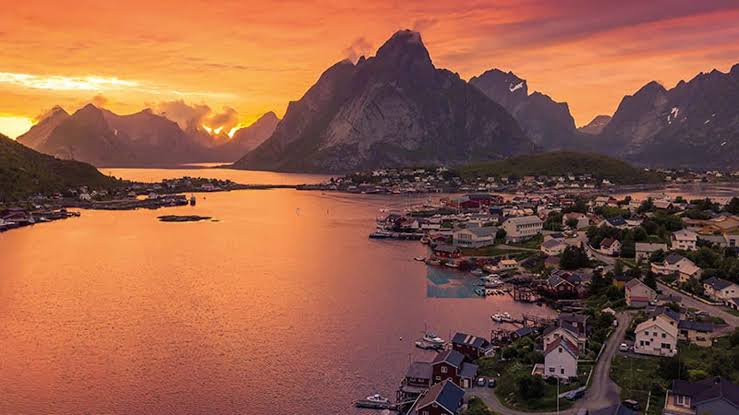By Jeremiah Aminu
Since the dawn of time, humanity has been driven by the curiosity to explain the mysteries that characterise the very fabric of existence. It is this curiosity that has prompted humankind to make cutting-edge discoveries that provide explanations concerning bizarre phenomena and places such as the operational process of time and space, gravity, stories about mysterious locations (one of which is the Bermuda Triangle), and many other universal wonders.
One of such bizarre events that has continuously piqued the interests of many is the unusual seasonal conditions in Northern Norway whereby, in particular seasons, the region does not experience the sunrise and the sunset. It is due to this that this Norwegian region is popularly known as the land of the “midnight sun” and “the polar night”.
By the midnight sun, according to Visitor Norway, it refers to a “natural phenomenon that occurs during the summer in places south of the Antarctic Circle and north of the Arctic Circle, including Northern Norway”. It is for this reason that the sun never completely descends into the horizon, since the earth rotates on an axis relative to the sun, causing the North Pole to face the sun during the summer season. This implies that the farther a person travels to the North, the longer they can witness the presence of sunlight in the sky, even at midnight.
READ ALSO: Norway coach Johansen hails Nigeria as group’s most physical team
In Norway, this celestial event tends to surface in mid-May to late July with varying time frames across regions in Northern Norway. For instance, the midnight sun, as stated by Guide to Lofoten, lasts up to four months in Svalbard, from approximately April 20 to August 23, thus making it the region that experiences the longest duration of the midnight sun due to its location in the North. At the Northern Cape (Nordkapp), the midnight sun lasts for three months from May 14 to July 29. Similarly, at Tromsø, the midnight sun, as well, does not descend below the horizon for three months from May 20 to July 22.
Equally notable is the effect of the midnight sun on the Northern Norwegians. In this regard, their circadian rhythm is often disrupted. By circadian rhythm, this refers to the body’s internal clock that influences a person’s cognitive and behavioural response with respect to the presence of light and darkness. Put simply, it influences a person’s alertness due to the presence of sunlight in the day and sleep due to the absence of sunlight in the night.
In the season of the midnight sun in Northern Norway, the sleep cycles of Norwegians are often disrupted due to the ever-enduring presence of sunlight in the sky. As such, they tend to engage in a tradition called “friluftsliv” (outdoor recreational activities) whereby they go hiking, kayaking, and camping to relish the beauty of nature and enjoy the season.
Another natural phenomenon that stands in contrast to the midnight sun in Northern Norway is the “polar night” (whereby the sun never rises above the horizon during the winter season). This celestial event surfaces in November and lasts until January. In this season, the Northern Norwegians employ certain strategies to survive and, at the same time, enjoy this beautiful season characterised by an absence of sunlight for weeks (and even months).
One of such strategies is the use of artificial lighting all around the towns and cities (even in workplaces) for them to conduct their businesses in the day, despite the absence of light. Sometimes, they rely on blueish natural light that illuminates the sky at dawn.
Furthermore, they also enjoy this season by engaging in outdoor recreational activities, some of which include cross-country skiing and ice skating. This tradition of engaging in outdoor activities in both celestial events (the midnight sun and the polar night) reflects their popular saying: “ingenting som dårlig vær, bare dårlig klær” (there’s no such thing as bad weather, only bad clothing).
Proceeding further, the polar night event tends to engender certain psychological effects for Northern Norwegians, most especially Seasonal Affective Disorder (SAD)—a mood disorder that is characterised by fatigue, depression, hopelessness, and social withdrawal as a result of less sunlight. As treatment, they often undergo light therapy, maintain active lifestyles, and engage more in social interactions and communal activities.
READ ALSO: Norway coach Johansen wary of ‘unpredictable’ Nigeria
In all, the midnight sun and the polar night are two celestial wonders that have served as a site of tourist attraction in Norway, particularly in the Northern region.
Despite the effects of these celestial events on Northern Norwegians, some of which include the disruption of their circadian rhythms (whereby their sleep cycles are affected) and Seasonal Affective Disorder, they, nonetheless, exalts the spirit of “friluftsliv” whereby they engage in outdoor recreational activities to relish and enjoy the beauty of both celestial seasons. Truly, as the Norwegians would often say: “There is no such thing as bad weather”.



